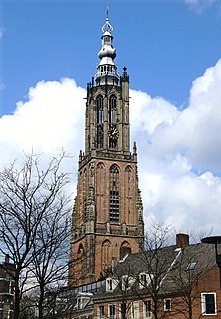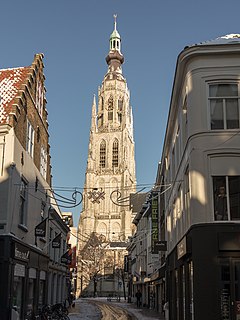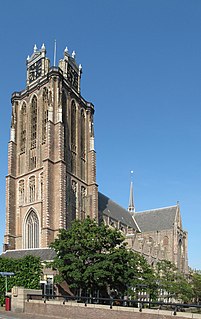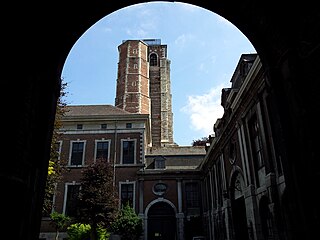
Leiden is a city and municipality in the province of South Holland, Netherlands. The municipality of Leiden has a population of 119,713, but the city forms one densely connected agglomeration with its suburbs Oegstgeest, Leiderdorp, Voorschoten and Zoeterwoude with 206,647 inhabitants. The Netherlands Central Bureau of Statistics (CBS) further includes Katwijk in the agglomeration which makes the total population of the Leiden urban agglomeration 270,879, and in the larger Leiden urban area also Teylingen, Noordwijk, and Noordwijkerhout are included with in total 348,868 inhabitants. Leiden is located on the Oude Rijn, at a distance of some 20 kilometres from The Hague to its south and some 40 km (25 mi) from Amsterdam to its north. The recreational area of the Kaag Lakes (Kagerplassen) lies just to the northeast of Leiden.

Heiloo is a municipality and town in the Netherlands, located in the province of North Holland. The community is part of the cooperation region Kennemerland and is located in the historical region of West Friesland. Heiloo had a population of 23,464 in 2019.

Dendermonde is a city in the Flemish province of East Flanders in Belgium. The municipality comprises the city of Dendermonde and the towns of Appels, Baasrode, Grembergen, Mespelare, Oudegem, Schoonaarde, and Sint-Gillis-bij-Dendermonde. Dendermonde is at the mouth of the river Dender, where it flows into the Scheldt. The town has a long-standing folkloric feud with Aalst, south along the same river, which dates from the Middle Ages.

Deinze is a city and a municipality in the Belgian province of East Flanders. It comprises the city of Deinze, and the towns of Astene, Bachte-Maria-Leerne, Gottem, Grammene, Meigem, Petegem-aan-de-Leie, Sint-Martens-Leerne, Vinkt, Wontergem, Zeveren, Nevele, Hansbeke, Landegem, Merendree, Poesele and Vosselare. On January 1, 2020, Deinze had a population of 43,580. The municipality's total area is 127.43 km2 (49 sq mi), giving a population density of 342 inhabitants per km².

Francis Cooke was a Leiden Separatist, who went to America in 1620 on the Pilgrim ship Mayflower, which arrived at Plymouth, Massachusetts. He was a founding member of the Massachusetts Bay Colony, and a signer of the Mayflower Compact.

The Saint-Salvator Cathedral is the cathedral of Bruges, Flanders, in present-day Belgium. The cathedral is dedicated to the Verrezen Zaligmaker and Saint-Donatius of Reims.

The Cathedral of Our Lady is a Roman Catholic cathedral in Antwerp, Belgium. Today's see of the Diocese of Antwerp started in 1352 and, although the first stage of construction was ended in 1521, has never been 'completed'. In Gothic style, its architects were Jan and Pieter Appelmans. It contains a number of significant works by the Baroque painter Peter Paul Rubens, as well as paintings by artists such as Otto van Veen, Jacob de Backer and Marten de Vos.

Zegge is a small village located in the municipality of Rucphen, North Brabant in the Netherlands. On 1 January 2020, the village had 2,045 inhabitants. Viewed from the four other villages in the municipality of Rucphen, Zegge is located on the other side of the A58 motorway. This combined with its small size, makes it so that much of the daily life of its inhabitants centers around the nearby city of Roosendaal.

François Hemony and his brother Pieter, Pierre, or Peter Hemony (1619-1680) were the greatest carillon bell founders in the history of the Low Countries. They developed the carillon, in collaboration with Jacob van Eyck, into a full-fledged musical instrument by casting the first tuned carillon in 1644.

The Church of Our Lady in Bruges, Belgium, dates mainly from the 13th, 14th and 15th centuries. This church is essentially "...a monument to the wealth, sophistication, taste, and devotion of this most Catholic city, whose history and faith stand today celebrated in this wonderful building."

The Leiden American Pilgrim Museum is a small museum in the Dutch city of Leiden dedicated to the Pilgrim Fathers. These Separatists or English Dissenters were religious refugees who had fled England to Amsterdam in 1608 and moved to Leiden the next year. They lived and worked in that city for about 12 to 20 years. In 1620, their emigration began. They left Leiden by canal, going to Delfshaven where they embarked on the Speedwell, which took them to Southampton. But the Speedwell proved leaky and had to be sold, so they transferred to the Mayflower. The Mayflower undertook the famous voyage to New England in 1620 alone. In the 19th century the colonists' first harvest festival after their arrival at Plymouth Colony was identified as the origin of the annual Thanksgiving celebration in the United States.

The Onze-Lieve-Vrouwetoren is a church tower in Amersfoort. The Late Gothic building is 98.33 metres tall and reaches high above the inner city. It is one of the most eye-catching monuments in town and the third highest church tower in the Netherlands. The nickname of the tower is Lange Jan. The church that belonged to the tower was destroyed by a gunpowder explosion in the 18th century.

The Grote Kerk or Onze-Lieve-Vrouwekerk is the most important monument and a landmark of Breda. The church is built in the Brabantine Gothic style. The tower of the church is 97 meters tall. The plan is in the shape of a Latin Cross.

The Basilica of Our Lady is a Romanesque church in the historic center of Maastricht, Netherlands. The church is dedicated to Our Lady of the Assumption and is a Roman Catholic parish church in the Diocese of Roermond. The church is often referred to as the Star of the Sea, after the church's main devotion, Our Lady, Star of the Sea.
Philip Delano arrived in Plymouth Colony in November 1621 on the voyage of the ship Fortune. He was about 18 years of age on arrival. Mayflower passenger Francis Cooke was his uncle with whom he may initially have resided. Philip Delano lived a long life in Plymouth Colony where he became a person of some note, being involved in numerous governmental activities such as civil commissions and juries. Among his early activities was in becoming a very young (investment) Purchaser in 1626 and making the first recorded land sale in Plymouth after the institution of private property. At his death it is believed he had become a person of some wealth.

The Grote Kerk of Dordrecht, officially the Church of Our Lady is a large church in the Brabantine Gothic style, and the largest church in the city. It was built between 1284 and 1470, though some parts are newer. It became a Protestant church in 1572, and remains an active church, now owned by the Protestant Church in the Netherlands.

The Church of Our Blessed Lady of the Sablon is a Roman Catholic church located in the Sablon/Zavel district in the historic centre of Brussels, Belgium. It is dedicated to Our Lady of the Sablon.

Sint-Truiden Abbey or St Trudo's Abbey is a former Benedictine monastery in Sint-Truiden in the province of Limburg Belgium. The abbey was founded in the 7th century and was one of the oldest and most powerful in the Low Countries. The town of Sint-Truiden grew up around it. The great Romanesque abbey church, dedicated to Saint Remaclus and Saint Quintin, was demolished in 1798, four years after the suppression of the abbey.

The church of Our Lady, Melsele is a Roman Catholic parish church in Melsele, in the commune of Beveren, in East Flanders, Belgium. It is a registered heritage site.

Ninove Abbey was a monastery of the Premonstratensian Order in the center of Ninove, in the province of East Flanders, Belgium. Only the abbey church now remains.





















